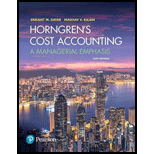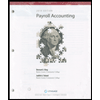
Labor cost, overtime, and idle time. David Letterman works in the production department of Northeast Plastics (NEP) as a machine operator David, a long-time employee of NEP, is paid on an hourly basis at a rate of $24 per hour. David works five 8-hour shifts per week Monday–Friday (40 hours). Any time David works over and above these 40 hours is considered overtime for which he is paid at a rate of time and a half ($36 per hour). If the overtime falls on weekends, David is paid at a rate of double time ($48 per hour). David is also paid an additional $24 per hour for any holidays worked, even if it is part of his regular 40 hours. David is paid his regular wages even if the machines are down (not operating) due to regular machine maintenance, slow order periods, or unexpected mechanical problems. These hours are considered “idle time.”
During December David worked he following hours:
| Hours worked including machine downtime | Machine downtime | |
| Week 1 | 50 | 6.0 |
| Week 2 | 44 | 2.0 |
| Week 3 | 46 | 4.0 |
| Week 4 | 45 | 3.5 |
Included in the total hours worked are two company holidays (Christmas Eve and Christmas Day) during Week 4. All overtime worked by David was Monday–Friday, except for the hours worked in Week 3; all of the Week 3 overtime hours were worked on a Saturday.
- 1. Calculate (a) direct manufacturing labor, (b) idle time, (c) overtime and holiday premium, and (d) total earnings for David in December.
- 2. Is idle time and overtime premium a direct or indirect cost of the products that David worked on in December? Explain.
Want to see the full answer?
Check out a sample textbook solution
Chapter 2 Solutions
Horngren's Cost Accounting: A Managerial Emphasis (16th Edition)
- Financial accountingarrow_forwardHatfield Corporation, which has only one product, has provided the following data concerning its most recent month of operations: Selling price $158 Units in beginning inventory 100 Units produced 1,720 Units sold 920 Units in ending inventory 900 Variable costs per unit: Direct materials $59 Direct labor $37 Variable manufacturing overhead $6 Variable selling and administrative $9 Fixed costs: Fixed manufacturing overhead $15,480 Fixed selling and administrative $17,480 What is the total period cost for the month under the variable costing? A- $32,960 B- $25,760 C- $41,240 D- $15,480arrow_forwardHelparrow_forward
- How much Total sales are required to achieve a net income of 160000?arrow_forwardGeneral accounting questionarrow_forwardHamilton Biotech has a profit margin of 8% and an equity multiplier of 2.8. Its sales are $150 million, and it has total assets of $60 million. What is Hamilton Biotech's Return on Equity (ROE)? Round your answer to two decimal places.arrow_forward
 Principles of Cost AccountingAccountingISBN:9781305087408Author:Edward J. Vanderbeck, Maria R. MitchellPublisher:Cengage Learning
Principles of Cost AccountingAccountingISBN:9781305087408Author:Edward J. Vanderbeck, Maria R. MitchellPublisher:Cengage Learning
 College Accounting (Book Only): A Career ApproachAccountingISBN:9781337280570Author:Scott, Cathy J.Publisher:South-Western College Pub
College Accounting (Book Only): A Career ApproachAccountingISBN:9781337280570Author:Scott, Cathy J.Publisher:South-Western College Pub College Accounting (Book Only): A Career ApproachAccountingISBN:9781305084087Author:Cathy J. ScottPublisher:Cengage Learning
College Accounting (Book Only): A Career ApproachAccountingISBN:9781305084087Author:Cathy J. ScottPublisher:Cengage Learning



